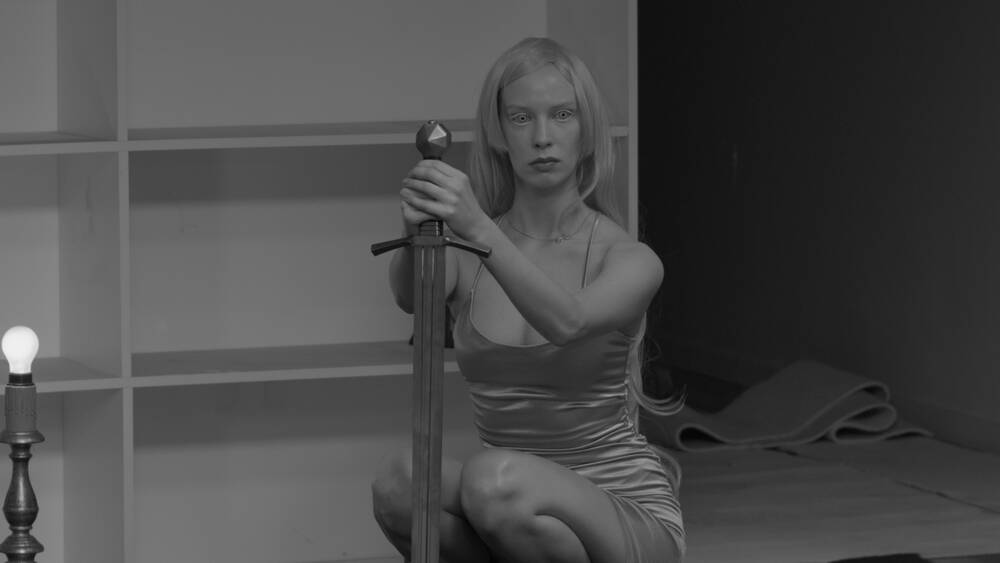In our next DOUBLE FEATURE, artist Margaret Haines will present her video work “On Air: Purity, Corruption & Pollution” (2024). Drawing on the life of Joan of Orléans (Jeanne d’Arc) and the ideas of occultist Cameron, Haines’ speculative sci-fi film centers on the notion of a female Messiah.
Paris, 2047. The young Charlot (Jette Loona Hermanis) enters a sparsely furnished room, in her hand a large sword and a throwing knife. Directly on the floor in front of her lies Boris (Joseph Wood) on a mattress watching her with expressionless eyes. A little later his blood will spread out across the room and soak his clothes.
As in the great sagas in human history, in Margaret Haines’ film “On Air: Purity, Corruption & Pollution” (2024) the act of violence fulfills a prophesy. Boris, or so we learned from the female narrator off-screen, is Charlot’s mythical twin brother from whom she was separated immediately after her birth. The two grew up with different parents, and without their having any knowledge of each other their biographies developed in diametrically opposing directions. While Charlot knew nothing of the prophesy that her adoptive mother once heard about her, she unknowingly and despite many detours embarks down her predestined path.
Between (eco)feminism, occultism, and prophesies
Campaign against nuclear power, somber villain, bands of human traffickers, (eco)feminism, occultism, witch burnings, prophesies, transhumanism, and biohacking: Margaret Haines’ latest video forges a sci-fi meta-cosmos replete with associations and powerful images and sounds. The film is profoundly influenced by Haines’ strong interest over the last decade in Marjorie Cameron Parsons Kimmel, often simply known as Cameron. The illustrious artist, poet, actress and occultist is today probably remembered, if at all, only by a few and then as the protagonist in Kenneth Anger’s “Inauguration of the Pleasure Dome”. Until his death, she was married to rocket propulsion expert Jack Parsons, himself an ardent follower of the occult teachings of Aleister Crowley, she herself delved deep into occultism and esotericism. The themes of sexual magic and mythical prophesies typical of these movements recur in her artistic work, although her oeuvre never received great attention during her lifetime and was first rediscovered in the last ten years or so. (An exhibition of the works of Wallace Berman at Ferus Gallery included one of her works that was deemed to be lewd, and the show was raided by the L.A: Vice Squad and Berman was arrested.)


When in 2009 Haines came across Cameron in Kenneth Anger’s afore-mentioned film a whole new world opened up to her: “I’m offered a window into […] ‘The Women Who Were Left in the Shadows’,” she wrote in an essay for her book “Love With Stranger X Coco”, in which she explored different tropes of female identity. In “On Air: Purity, Corruption & Pollution” there are also references to French resistance fighter Jeanne d’Arc, whom the Catholic Church judged a heretic and condemned to death by burning at the stake, but who today is revered in France as a virgin and saint. In the form of speculative fiction, in her film Haines thus creates an associative focus on those women who were sentenced to obscurity in a world determined by the patriarchy. At the same time, the mythological allusions in the piece can be read as an attempt to write an alternative feminist historiography.
Carl Theodor Dreyer’s “La Passion de Jeanne d’Arc”
At the end of her film, Margaret Haines explicitly refers to the short life of Jeanne d’Arc; by contrast, in 1928 in his film “La Passion de Jeanne d'Arc” Carl Theodor Dreyer exhaustively explored the story of her suffering. In the context of the Hundred Years War between France and England, the young woman decisively influenced the course of the conflict after initially convincing the French Dauphin of the vision sent to her by God of France’s fate and then also being successful in the military campaign, for example by driving the English out of Orléans. Dreyer’s silent movie concentrates, however, completely on the trial by inquisition that the Bishop of Beauvais brought against Jeanne d'Arc (Renée Falconetti). Dreyer wrote the script after spending a year researching her life and it is based on the original transcripts of the trial, which involved her being interrogated 29 times.


Carl Theodor Dreyer, La Passion de Jeanne d'Arc, 1928, Image via moviebreak.de
The film is considered a milestone of film history and remains impressive to this day thanks to its exquisite camera work and Renée Falconetti’s marvelous acting – entire worlds seem to take place in her face. Visually and in terms of the dramatics and staging, Dreyer links the passion of Jeanne D’Arc with that of Jesus Christ, whereby the English soldiers and the clergymen are identified as the tormentors. Not least probably for this reason, on its release the film was forbidden in England, while at the insistence of the French archbishop the film produced in France had repeatedly to be re-edited by Dreyer’s production company. “Nowhere is paradise”, Charlot 2047 announces in Margaret Haines’ “On Air: Purity, Corruption & Pollution”, spotlighting the “exclusion of women from sacred”. This can be seen to this day: Jeanne D’Arc was made a saint in 1920, almost 500 years after her murder.









